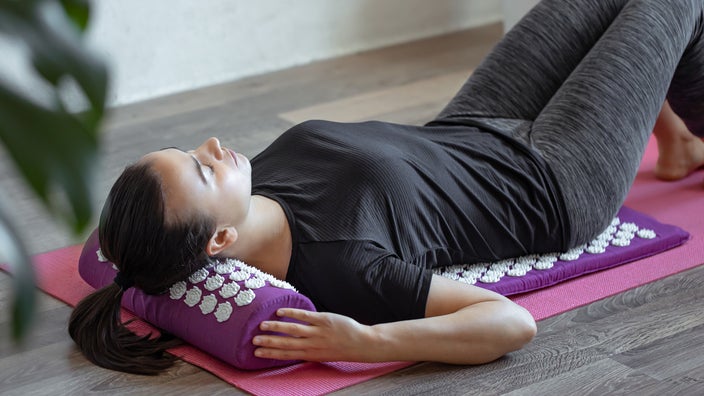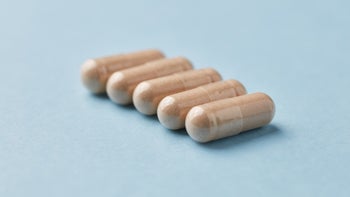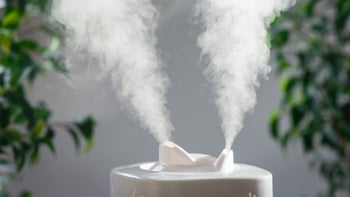
Do Acupressure Mats Work to Relieve Pain?
Key takeaways:
Acupressure mats are covered with plastic spikes that apply pressure to specific points on your body.
There's a need for more research on the benefits of acupressure mats. But they may help relieve neck and back pain, muscle tension, headaches, and stress.
Most people can use acupressure mats, because they are inexpensive, noninvasive, and have minimal side effects.
Table of contents

If you are dealing with back pain, headaches, or stress, an acupressure mat might help. Using an acupressure mat can be an effective and all-natural way to ease your symptoms from the comfort of your home. Instead of a practitioner using their hands to apply pressure to specific parts of your body, the mat does all the work.
Acupressure is an offshoot of acupuncture, a therapy that originated in China over 3,000 years ago. Less invasive than acupuncture — which involves thin needles — acupressure involves putting pressure on trigger points. Although the practice is ancient, acupressure mats are a more recent tool. And using one could help you in a variety of ways.
What is an acupressure mat?
An acupressure mat (also called a spike mat or needle stimulation pad) is a pad that is covered with spikes made of plastic. They are made to press into the skin without puncturing it. You can sit, stand, or lie on an accupressure mat, depending on your intended use.
Search and compare options
The concept is simple: The mat applies pressure to specific points on the body called meridians, pressure points, or acupoints. It works the same way that acupressure or acupuncture does.
According to traditional Chinese medicine, applying pressure to these points helps diffuse blocked meridians, restores balance, and relieves pain. Research suggests that putting pressure on these points also boosts circulation, eases muscle tension, and stimulates endorphins to help relieve pain.
The mats come in different sizes to fit your needs. You can lay your entire body on larger mats. And you can use smaller mats directly on painful areas, such as your neck or feet. You don't need a prescription to get an acupressure mat; you can simply buy one online or at one of the many retail or wellness chains that carry them.
What are the benefits of using acupressure mats?
Acupressure mats are noninvasive, inexpensive, and convenient tools with few potential side effects. However, while there are many studies on the benefits of acupressure and acupuncture, there's a need for more research on acupressure mats.
Some of the potential benefits are the same as what you might experience with traditional acupressure, since the mats mimic the technique. Keep in mind that an acupuncture professional can target a specific problem area, whereas the mats treats several points or a much broader area at once.
Let's look at six potential benefits of using acupressure mats and find out what experts say about their effectiveness.
Read more like this
Explore these related articles, suggested for readers like you.
1. Eases muscle tension and promotes relaxation
One small study found that participants who used acupressure mats had signs of greater circulation in their backs, which could help alleviate muscle tension. Participants who used the mats were also more relaxed, with lower heart rates and slower breathing.
2. Relieves chronic neck, back, and foot pain
Less muscle tension could mean fewer aches and pains. In small studies, acupressure mats have been shown to lessen chronic neck and lower back pain. But there’s a need for more extensive research.
Standing on an acupressure mat may also reduce foot pain. A study analyzed the effects of reflexology in children with chronic foot pain. Similar to acupressure, reflexology involves applying pressure to specific points on the feet. The children had significantly less pain and less anxiety after one reflexology session.
3. Reduces menstrual pain
There haven’t been any studies on acupressure mats for menstrual pain. But studies have found potential benefits with acupressure.
One study examined how 10 minutes of acupressure on trigger points in the hands and feet affected menstrual cramps. It found that participants had less pain, fewer medication needs, and fewer school absences.
If you want to use an acupressure mat to relieve menstrual pain, try standing on it for 10 minutes. You can also place your hands on the mat for the same amount of time to activate trigger points.
4. Alleviates chronic headaches
A small study looked at how acupressure affects headaches. It found that using the technique on trigger points around the head and back of the neck reduced chronic headaches better than muscle relaxants. Look for acupressure mats that have a cervical roll with spikes to take advantage of this possible benefit. That way, the spikes will hit the nape of your neck and base of your skull.
5. Helps depression, anxiety, and stress
Could lying on an acupressure mat improve your mental health? Possibly. Researchers tested this in a very small study. And participants reported improved well-being, more energy, better sleep, and less pain.
Larger-scale studies have also found that acupressure mats may help with mild-to-moderate depression symptoms. In other studies, the mats have been shown to lower stress and anxiety in hemodialysis patients.
6. Boosts your energy levels
Standing on an acupressure mat may help limit fatigue. A meta-analysis found that study participants who performed reflexology on themselves reported less stress and more energy. Although participants reported these positive outcomes, their blood pressure, pulse, and cortisol levels (measures of stress response) remained unchanged. So the study pointed out that more research is needed.
How do acupressure mats work?
Most people can use acupressure mats. But there can be some risks, so certain people should avoid using them or take caution to avoid piercing their skin. This includes people with diabetes, thin skin, open wounds, bleeding disorders, or poor circulation. If you are pregnant, talk to your primary care provider before using an acupressure mat, as it could induce labor.
Once you know it's safe to use an acupressure mat, you should be good to go. Most acupressure mats look like small yoga mats with spikes. And some come with a rounded cervical pillow for your neck.
Here are some suggestions on how to use your acupressure mat in a lying down or sitting position:
Spread your mat out on the floor or a bed where you can comfortably lie down. Or you can lay it over a chair to sit on it.
You may want to wear a lightweight T-shirt, or use a thin sheet as a layer between you and the mat, to get accustomed to the feeling.
Slowly sit or lie down on the mat, keeping your weight evenly distributed.
After you get accustomed to the mat, remove your shirt or the sheet. Bare skin provides the best results.
Studies have shown that pain from acupressure mat spikes peaks in 30 seconds and then typically diminishes. So the tingling, warmth, or pulsating feeling you may experience at first should go away quickly.
Take slow, deep breaths and try to relax.
Start with 5-10 minutes and work up to 20-30 minutes on the mat daily.
Don't wiggle or shift too much when you’re on the mat to avoid scratching yourself.
Allow yourself to relax, but don't fall asleep on the mat.
Here are some tips for standing on your mat:
You can start with socks and work up to bare feet.
Stand still on the mat.
You can also sit down in a chair and place your feet on the mat to start.
Start with 5 minutes and work your way up.
What is the best acupressure mat?
When buying an acupressure mat, keep in mind the following factors:
Size: There are several options depending on what part of the body you want to target. If you are planning to rest your entire body on the mat, make sure it is long enough. You can also find cervical rolls for neck or headache pain and smaller reflexology acupressure pads for your feet.
Spikes: The spikes should be well-made and be able to withstand pressure without breaking or bending. Many mats also vary in the number of spikes they have, with more spikes for beginners and fewer for those who are more advanced. The more spikes on a mat, the more your weight is distributed for less discomfort.
Material: You will find mats made from eco-friendly materials like organic cotton, as well as mats made from synthetic materials. Choose a mat that is durable, comfortable, and within your price range. Be mindful of any skin allergies when searching for the right mat, as well.
Price: The price of acupressure mats varies by material. Organic or eco-friendly materials will cost more than synthetic. It also depends on the spike quality and any extras that come with the mat, such as a carrying case, cervical roll, or warranty.
The bottom line
Acupressure mats allow you to get the benefits of acupressure from home. They are easy to use, noninvasive (unlike acupuncture), and have few potential side effects. Although more research is needed, using an acupressure mat may help relieve pain, fatigue, muscle tension, and stress. And it might even help you sleep better. While it may not work for everyone, using an acupressure mat is a good choice for those looking for an alternative approach to health and wellness.
Why trust our experts?



References
Bertrand, A., et al. (2019). Evaluation of efficacy and feasibility of foot reflexology in children experiencing chronic or persistent pain. Bulletin du Cancer.
Frizziero, A., et al. (2021). Efficacy of an acupressure mat in association with therapeutic exercise in the management of chronic low back pain: A prospective randomized controlled study. Applied Sciences.
Hao, J. J., et al. (2014). Acupuncture: Past, present, and future. Global Advances in Health and Medicine.
Hmwe, N. T. T., et al. (2015). The effects of acupressure on depression, anxiety and stress in patients with hemodialysis: A randomized controlled trial. International Journal of Nursing Studies.
Hohmann, C., et al. (2012). The benefit of a mechanical needle stimulation pad in patients with chronic neck and lower back pain: Two randomized controlled pilot studies. Hindawi.
Hsieh, L. L. C., et al. (2010). Effect of acupressure and trigger points in treating headache: A randomized controlled trial. American Journal of Chinese Medicine.
Kirca, A. S., et al. (2022). The effect of acupressure on menstrual pain. International Journal of Traditional and Complementary Medicine Research.
Kjellgren, A., et al. (2011). Does relaxation on a bed of nails (spike mat) induce beneficial effects? A randomized controlled pilot study. Alternative Medicine Studies.
Lin, J., et al. (2022). Impacts of acupressure treatment on depression: A systematic review and meta-analysis. World Journal of Psychiatry.
Mehta, P., et al. (2017). Contemporary acupressure therapy: Adroit cure for painless recovery of therapeutic ailments. Journal of Traditional and Complementary Medicine.
Olsson, E. M. G., et al. (2011). Relaxing on a bed of nails: An exploratory study of the effects on the autonomic, cardiovascular, and respiratory systems, and saliva cortisol. Journal of Alternative and Complementary Medicine.
Song, H. J., et al. (2015). Effect of self-administered foot reflexology for symptom management in healthy persons: A systematic review and meta-analysis. Complementary Therapies in Medicine.
Thiagarajah, A. G. (2017). How effective is acupuncture for reducing pain due to plantar fasciitis? Singapore Medical Journal.
University of Minnesota. (n.d.). How does reflexology work?




























